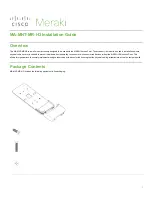
4
5
INSTALLATION
This installation should be made by a qualified service
person and conform to all local codes.
Do Not Exceed 30VAC Input on 24VAC models.
Operation above 30VAC violates low voltage operation
(Class 2 Specifications). Normal operation is 24VAC.
5.1
Mounting
Refer to
Figure 1A
.
1.
Using the Wall Mount base as a template, mark the
mounting hole locations on the mounting surface.The
unit is intended to be mounted with four screws and
anchors or threaded inserts (not supplied) through
the four holes in the base casting of the mount.The
wall should be able to bear four (4) times of the
weight of the complete dome unit. Pre-drill the holes
as marked.
Refer to
Figure 1B
2.
Drill a fifth hole in the center of the 4 base mount
holes. Use this hole for the wiring cables and power
connections. Pull all wires and cables from the wall
trough this hole.
Refer to
Figure 1C
3.
Install the appropriate anchors or threaded inserts at
the locations marked in step 1.
4.
Connecting Low Voltage Power
The wiring harness has a BNC connector to accept
video coax and two stripped leads to accept the low
voltage power.
Connect the line and neutral wires from the wall to
the line and neutral wires from the dome.
Caution:
Before proceeding to disconnect the
power at its source, be sure that the unit is of the
proper voltatge type for the line power.
Note:
24 VAC Applications: Camera operation is not
affected by the polarity of the 24 VAC wires.
However, in multiple camera systems, consistent
wiring configurations will help maintain roll-free
switching.
Connecting Video Cable
Route and connect video cable to BNC
connector.
5.
Attach the Wall mount to the wall using appropriate
fastners.
Use base as template to mark
the 4 screw holes for mounting.
Wall Mount
Dome
Trim Ring
Polycarbonate bubble
Hole for wires
Figure 1 A
Drill 5th hole for
Wiring.
BNC
Connector
Line and
Neutral
connections
Figure 1 B
Figure 1 C


























